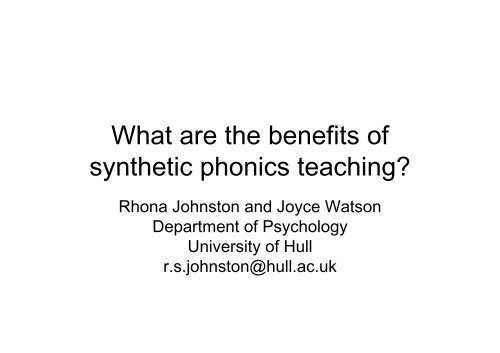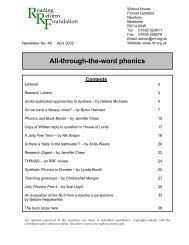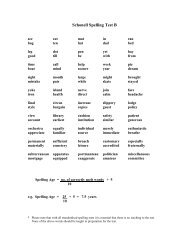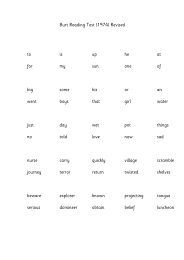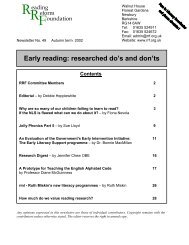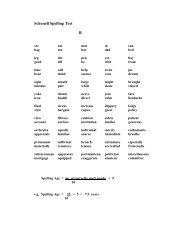What are the benefits of What are the benefits of synthetic phonics ...
What are the benefits of What are the benefits of synthetic phonics ...
What are the benefits of What are the benefits of synthetic phonics ...
Create successful ePaper yourself
Turn your PDF publications into a flip-book with our unique Google optimized e-Paper software.
<strong>What</strong> <strong>are</strong> <strong>the</strong> <strong>benefits</strong> <strong>of</strong><br />
syn<strong>the</strong>tic <strong>phonics</strong> teaching<br />
Rhona Johnston and Joyce Watson<br />
Department <strong>of</strong> Psychology<br />
University <strong>of</strong> Hull<br />
r.s.johnston@hull.ac.uk
Our studies <strong>of</strong> analytic and<br />
syn<strong>the</strong>tic <strong>phonics</strong><br />
• From 1992-95 we studied <strong>the</strong> implementation <strong>of</strong><br />
analytic <strong>phonics</strong> in 12 classes in Scottish<br />
primary schools<br />
• From 1995-7 we carried out our first intervention<br />
study comparing analytic and syn<strong>the</strong>tic <strong>phonics</strong>.<br />
• From 1997-2004 we carried out a comparison<br />
between analytic and syn<strong>the</strong>tic <strong>phonics</strong> (<strong>the</strong><br />
Clackmannanshire Study).
<strong>What</strong> is Syn<strong>the</strong>tic Phonics<br />
• Starts before children <strong>are</strong> introduced to<br />
reading scheme books, before any sight<br />
word recognition is established<br />
• Teaches letter sounds very rapidly, explicitly<br />
showing children how to sound and blend<br />
letters in all positions <strong>of</strong> words right from <strong>the</strong><br />
start<br />
t<br />
• Words <strong>are</strong> not pronounced for children prior to <strong>the</strong>m<br />
sounding and blending <strong>the</strong>m<br />
• Sounding and blending is taught in <strong>the</strong> first few weeks<br />
<strong>of</strong> formal schooling
<strong>What</strong> is Analytic Phonics<br />
• Children start t out by recognising i whole words.<br />
• The sounds for <strong>the</strong> letters <strong>of</strong> <strong>the</strong> alphabet <strong>are</strong> taught in<br />
<strong>the</strong> context <strong>of</strong> alliterative words, <strong>of</strong>ten one week for each<br />
letter, e.g. gate, green, girl, glove etc<br />
• Letter sounds <strong>are</strong> <strong>the</strong>n taught at <strong>the</strong> end <strong>of</strong> words<br />
• When letter sounds <strong>are</strong> taught in <strong>the</strong> middle <strong>of</strong> words,<br />
CVC words <strong>are</strong> introduced<br />
• Sounding and blending is introduced d when CVC words<br />
<strong>are</strong> taught<br />
• It gradually progresses to teaching blends and digraphs,<br />
e.g. clip, coat, fast
<strong>What</strong> is phonemic aw<strong>are</strong>ness<br />
• Phonemes <strong>are</strong> <strong>the</strong> smallest<br />
meaningful units <strong>of</strong> sounds in words<br />
• Phonemic aw<strong>are</strong>ness is <strong>the</strong> ability to<br />
hear and pronounce phonemes, without<br />
access to print<br />
• Phonics is an approach to teaching<br />
reading that connects letters<br />
with phonemes, e.g. f - l - a - g
First syn<strong>the</strong>tic and analytic <strong>phonics</strong><br />
study,1995-97<br />
• All <strong>of</strong> <strong>the</strong> children carried out <strong>the</strong>ir<br />
classroom analytic <strong>phonics</strong> programme in<br />
addition to <strong>the</strong> intervention<br />
• The programme started shortly after <strong>the</strong>y<br />
started school<br />
• The extra training was in small groups for<br />
two 15 minute sessions a week. Total<br />
teaching time was 4.75 hours
1995-97 Study Intervention Conditions<br />
i) Controls, n = 29<br />
The children were exposed to <strong>the</strong> new print and<br />
were told what <strong>the</strong> items said.<br />
ii) Accelerated letter learning group, n = 33<br />
Two letters a week were taught. These letter sounds<br />
were taught in <strong>the</strong> context <strong>of</strong> <strong>the</strong> new print vocabulary,<br />
in <strong>the</strong> initial position <strong>of</strong> words.<br />
iii) Syn<strong>the</strong>tic <strong>phonics</strong> group, n = 30<br />
The children learnt two letters per week, but were<br />
shown <strong>the</strong>m in initial, middle and final positions <strong>of</strong><br />
<strong>the</strong> words. They were taught to sound and blend <strong>the</strong><br />
letters in order to pronounce <strong>the</strong> words. They also<br />
segmented spoken words for spelling.
Reading and spelling ability at start <strong>of</strong> second year at school<br />
6.4<br />
6.2<br />
6<br />
Years<br />
5.8<br />
56 5.6<br />
5.4<br />
Reading<br />
Spelling<br />
Age<br />
5.2<br />
5<br />
4.8<br />
No letters Accelerated letters Syn<strong>the</strong>tic <strong>phonics</strong>
% cor rrect<br />
90<br />
80<br />
70<br />
60<br />
50<br />
40<br />
30<br />
20<br />
10<br />
0<br />
Letter knowledge, phoneme segmentation,<br />
rhyme skills and nonword reading at start <strong>of</strong><br />
second year at school<br />
No letters Accelerated Syn<strong>the</strong>tic<br />
letters <strong>phonics</strong><br />
Letter knowledge<br />
Phoneme<br />
segmentation<br />
Rhyme skills<br />
Nonwords
Clackmannanshire Study<br />
1997-2004<br />
• This study implemented analytic and syn<strong>the</strong>tic<br />
ti<br />
<strong>phonics</strong> programmes at <strong>the</strong>ir typical speeds<br />
• This allowed an examination <strong>of</strong> <strong>the</strong> effects <strong>of</strong><br />
direct phoneme aw<strong>are</strong>ness training in a third<br />
condition<br />
• The amount <strong>of</strong> time spent on <strong>phonics</strong> and<br />
related teaching was held constant, and <strong>the</strong><br />
groups were exposed to <strong>the</strong> same set <strong>of</strong> printed<br />
words<br />
• The rest <strong>of</strong> <strong>the</strong> reading programme continued<br />
unchanged
Intervention Conditions<br />
i) *Analytic Phonics Group, n =104<br />
The controls carried out a systematic analytic <strong>phonics</strong><br />
programme, learning one letter sound per week.<br />
ii) *Analytic Phonics + Phonemic Aw<strong>are</strong>ness Group, n = 75<br />
This group also learnt to read by a systematic analytic<br />
<strong>phonics</strong> method, but half <strong>of</strong> <strong>the</strong>ir programme was devoted<br />
to <strong>the</strong> syn<strong>the</strong>sis and analysis <strong>of</strong> sounds in spoken words.<br />
iii) Syn<strong>the</strong>tic Phonics Group, n = 113<br />
Letter sounds were taught at <strong>the</strong> pace <strong>of</strong> 6 letters<br />
every 8 days. They sounded and blended words in order<br />
to read <strong>the</strong>m, and segmented spoken words for spelling<br />
(i.e. analysis and syn<strong>the</strong>sis <strong>of</strong> sounds with letters).<br />
*At <strong>the</strong> end <strong>of</strong> <strong>the</strong> programmes after post testing <strong>the</strong> first two groups<br />
*At <strong>the</strong> end <strong>of</strong> <strong>the</strong> programmes, after post-testing, <strong>the</strong> first two groups<br />
carried out <strong>the</strong> syn<strong>the</strong>tic <strong>phonics</strong> programme.
Duration <strong>of</strong> Programme in<br />
Clackmannanshire<br />
• The programme started in <strong>the</strong> middle <strong>of</strong><br />
September <strong>of</strong> <strong>the</strong> first year at school with around 300<br />
children<br />
• The sessions were 20 minutes a day for<br />
16 weeks, and were carried out with <strong>the</strong> whole class<br />
• Reading scheme books were introduced<br />
in November
Clackmannanshire Sample<br />
• Clackmannanshire is in <strong>the</strong> top 10% for<br />
deprivation in Scotland.<br />
• Around half <strong>of</strong> our sample came from<br />
<strong>are</strong>as <strong>of</strong> moderate to severe deprivation,<br />
<strong>the</strong> o<strong>the</strong>r half came from moderately<br />
advantaged <strong>are</strong>as
Tests Used<br />
• British Abilities Word Reading test t (from Primary<br />
6 WRAT Word Reading Test)<br />
• Schonell Spelling Test (from Primary 7 WRAT<br />
Spelling Test)<br />
• Primary Reading Test (from Primary 4 Group<br />
Reading Test)<br />
• British Picture Vocabulary Scale in Primary 1 (in<br />
Primary 6 English Picture Vocabulary Test)<br />
• Yopp-Singer phoneme segmentation test in<br />
Primary 1<br />
• Nonword reading test in Primary 1
Reading and Spelling at <strong>the</strong> end <strong>of</strong> <strong>the</strong> programme,<br />
Easter <strong>of</strong> <strong>the</strong> first year at school<br />
6.2<br />
6<br />
5.8<br />
Years<br />
5.6<br />
5.4<br />
5.2<br />
Chronological l Age<br />
Word Reading Age<br />
Spelling<br />
5<br />
4.8<br />
4.6<br />
Analytic Phonics Analytic Phonics+Phonemic Syn<strong>the</strong>tic Phonics<br />
aw<strong>are</strong>ness training
Phonemic Aw<strong>are</strong>ness at <strong>the</strong> end <strong>of</strong> <strong>the</strong> programme, Easter <strong>of</strong> <strong>the</strong><br />
first year at school<br />
70<br />
60<br />
50<br />
% corre ect<br />
40<br />
30<br />
20<br />
10<br />
0<br />
Analytic Phonics<br />
Analytic Phonics+Phonemic<br />
Aw<strong>are</strong>ness<br />
Syn<strong>the</strong>tic Phonics
Reading and spelling at <strong>the</strong> end <strong>of</strong> <strong>the</strong> second year at school<br />
7.8<br />
7.6<br />
7.4<br />
7.2<br />
Year rs<br />
7<br />
6.8<br />
6.6<br />
6.4<br />
6.2<br />
Chronological Age Word Reading Age Spelling Age Reading comprehension
Reading and spelling at <strong>the</strong> end <strong>of</strong> <strong>the</strong> third year at school, boys<br />
versus girls<br />
10<br />
9.5<br />
9<br />
Yea ars<br />
8.5<br />
8<br />
7.5<br />
Primary 3 Boys<br />
Primary 3 Girls<br />
7<br />
6.5<br />
6<br />
Chronological l Age Word Reading Age Spelling Age Reading<br />
comprehension
Reading and spelling at <strong>the</strong> end <strong>of</strong> <strong>the</strong> seventh year at school, boys versus girls<br />
18<br />
16<br />
14<br />
12<br />
10 Boys<br />
8<br />
Girls<br />
6<br />
4<br />
2<br />
0<br />
Age Reading Age Spelling Age Reading Comprehension
Proportion <strong>of</strong> underachievers in second to seventh year at school<br />
100<br />
90<br />
80<br />
70<br />
%<br />
60<br />
50<br />
40<br />
Word Reading<br />
Spelling<br />
Reading Comprehension<br />
30<br />
20<br />
10<br />
0<br />
Primary 2 Primary 3 Primary 4 Primary 5 Primary 6 Primary 7
Summary <strong>of</strong> effects <strong>of</strong> social<br />
background,1997-2004<br />
Children from <strong>are</strong>as <strong>of</strong> deprivation only<br />
started to fall behind <strong>the</strong> more advantaged<br />
children towards <strong>the</strong> end <strong>of</strong> primary<br />
schooling in word reading, spelling and<br />
reading comprehension
Comparison <strong>of</strong> Clackmannanshire<br />
sample with English sample<br />
• A subset <strong>of</strong> <strong>the</strong> Clackmannanshire sample in<br />
Primary 6 was matched with a sample in<br />
England tested in Year 5/6.<br />
• Some <strong>of</strong> <strong>the</strong> English children were tested early<br />
in Year 6 to control for time at school<br />
The English sample was taught by Progression<br />
• The English sample was taught by Progression<br />
in Phonics, a form <strong>of</strong> analytic <strong>phonics</strong>
Comparison <strong>of</strong> Clackmannanshire and English sample, aged 10<br />
Standardised<br />
d score<br />
140<br />
130<br />
120<br />
110<br />
100<br />
90<br />
80<br />
70<br />
60<br />
50<br />
40<br />
30<br />
20<br />
10<br />
England<br />
Clackmannanshire<br />
0<br />
Vocabulary knowledge Word reading Reading<br />
comprehension<br />
Spelling
Word reading<br />
% children with scores more than 15<br />
points below 100<br />
Sample %<br />
England 12.7<br />
Clackmannanshire 4.7
Reading comprehension<br />
% children with scores more than 15<br />
points below 100<br />
Sample %<br />
England 22.0<br />
Clackmannanshire 9.4
Spelling<br />
% children with scores more than 15<br />
points below 100<br />
Sample %<br />
England 27.0<br />
Clackmannanshire 4.2
Gender differences in word reading,<br />
Clackmannanshire versus England<br />
• The SP taught boys read words better<br />
than <strong>the</strong> SP taught girls.<br />
•The AP taught boys read words as well as<br />
e taug t boys ead o ds as e as<br />
<strong>the</strong> AP taught girls
Gender differences in reading<br />
comprehension<br />
• The SP taught boys had reading<br />
comprehension as good as that <strong>of</strong> SP<br />
taught girls<br />
• The AP taught boys had reading<br />
comprehension scores lower than <strong>the</strong> AP<br />
taught girls
Gender differences in spelling<br />
• The SP taught boys spelt as well as <strong>the</strong><br />
SP taught girls<br />
•The AP taught boys spelt less well than<br />
e taug t boys spe t ess e t a<br />
<strong>the</strong> AP taught girls.
Time per week on literacy activities in Reception<br />
class, Logan and Johnston (submitted)<br />
Analytic<br />
Time<br />
Syn<strong>the</strong>tic<br />
Time<br />
<strong>phonics</strong><br />
<strong>phonics</strong><br />
Phonics 0.80 hours Phonics<br />
(reading,<br />
spelling,<br />
writing)<br />
Big Books/story<br />
time/whole word<br />
reading<br />
Individual<br />
reading<br />
Writing activities<br />
3.50 hours Big Books/story<br />
time activities<br />
3.33 hours<br />
1.50 hours<br />
0.20 hours Group reading 0.42 hours<br />
2.50 hours<br />
Total 7.00 hours Total 5.25 hours<br />
Reading Age 5.1 years Reading Age 5.45 years
Does syn<strong>the</strong>tic <strong>phonics</strong> teaching<br />
help underachievers<br />
Case Study <strong>of</strong> AF<br />
At <strong>the</strong> start <strong>of</strong> <strong>the</strong> programme, AF’s mean<br />
vocabulary score was 78. He had a history<br />
<strong>of</strong> delayed speech and language<br />
development coupled with a hearing<br />
difficulty, and he had a delayed start to<br />
schooling.
AF’s Individual Educational<br />
Programme<br />
This programme aimed to<br />
develop AF’s delayed language<br />
skills and poor motor coordination.
AF<br />
A speech <strong>the</strong>rapist and learning<br />
support teacher worked on his poor<br />
articulation, oral communication,<br />
listening and attention skills, and<br />
understanding <strong>of</strong> grammatical<br />
structures.
AF<br />
There was also work on his sound<br />
blending, visual memory, visual<br />
discrimination and visual closure, and<br />
<strong>the</strong>re was a motor movement<br />
programme to improve spatial<br />
perception and fine motor control.
AF<br />
P1 P2 P3 P4<br />
Age 63 6.3 76 7.6 87 8.7 93 9.3<br />
Reading Age 00 0.0 56 5.6 61 6.1 68 6.8<br />
Spelling Age 0.0 0.0 - 7.0<br />
Comprehension - - - -<br />
Vocabulary 78.0<br />
knowledge
AF<br />
In Primary 5, AF started to get help<br />
with his reading and spelling from a<br />
very experienced Support for<br />
Learning teacher. His programme<br />
revisited sted syn<strong>the</strong>tic etc <strong>phonics</strong>, and he<br />
had a handwriting and reading<br />
comprehension programme.
AF<br />
P4<br />
P5<br />
Age 93 9.3 10.6<br />
Reading Age 6.8 9.2<br />
Spelling Age 7.0 8.9<br />
Comprehension - 8.0<br />
Vocabulary<br />
knowledge<br />
75.0
% correct nonword reading<br />
‘plud’ ‘wolp’ ‘yoot’ ‘sode’ ‘blain’<br />
AF 91.6 100.0 100.0 75.0 75.0<br />
Reading 71.8 76.9 72.5 65.9 65.5<br />
age<br />
controls<br />
(Analytic<br />
<strong>phonics</strong><br />
taught)
AF<br />
P6<br />
P7<br />
Age 11.4 12.4<br />
Reading Age 10.2 12.4<br />
Spelling Age 10.1 11.2<br />
Comprehension - 7.1
Summary<br />
• Overall, <strong>the</strong> syn<strong>the</strong>tic <strong>phonics</strong> approach<br />
developed better reading and spelling<br />
skills than analytic <strong>phonics</strong><br />
• Boys read and spelt at least as well as<br />
girls with syn<strong>the</strong>tic <strong>phonics</strong>, which was<br />
not generally <strong>the</strong> case with analytic<br />
<strong>phonics</strong> teaching
Summary<br />
• The syn<strong>the</strong>tic <strong>phonics</strong> programme<br />
reduced <strong>the</strong> effects <strong>of</strong> social disadvantage on<br />
reading and spelling skills for much <strong>of</strong><br />
primary schooling<br />
• Levels <strong>of</strong> underachievement were<br />
much lower with syn<strong>the</strong>tic <strong>phonics</strong><br />
teaching<br />
• A special needs child made excellent<br />
progress with a syn<strong>the</strong>tic <strong>phonics</strong><br />
revisiting programme
Conclusions<br />
There is considerably less waste with<br />
syn<strong>the</strong>tic <strong>phonics</strong> teaching


